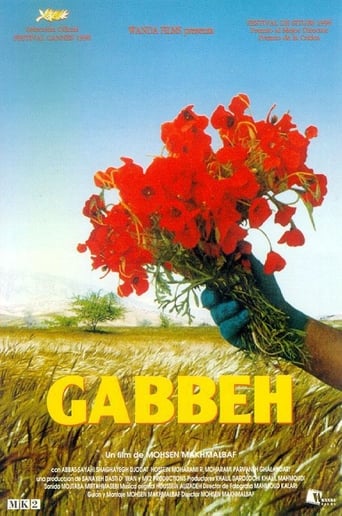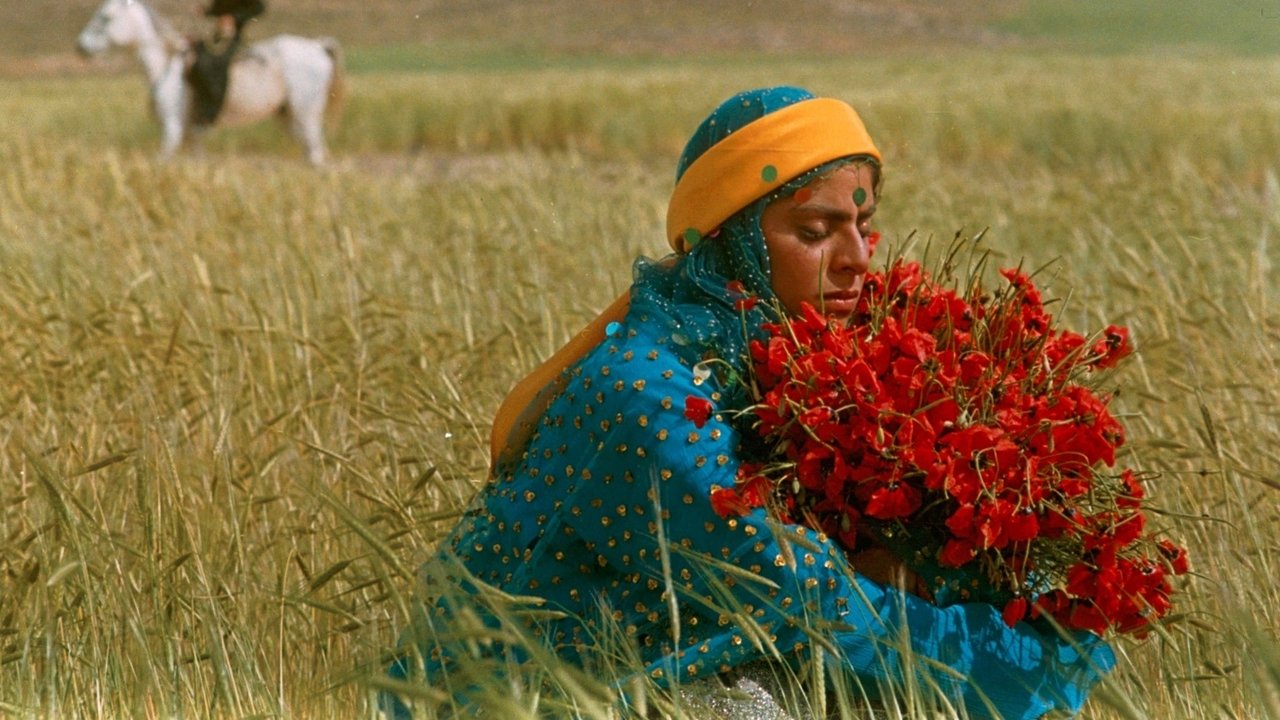Joshua Weatherl
This is, without a doubt, one of the most beautiful films I have ever seen. Gabbeh, an Iranian film which chronicles the complex life of a young girl and her family who live in the mountains of Iran herding goats, is told with such conviction and simplicity, that it is hard not to fall in love with this film.The narrative displays non-Western conventions, while remaining simple and easy to follow for a Western audience. It is actually quite refreshing to see a film that is told in the way Gabbeh is told.The content of the film is brilliant, with themes of nature, life's beauty and misfortune and complex family relationships. The use of color, which is arguably one of the most unique and interesting features of this film, warrant at least one viewing, if not multiple. Also, using the rug, or, gabbeh, as the film's centerpiece is a wonderful visual anchor, and reads well for a Western audience.If the story is not enough to sell this film, the cinematography more than makes up for any mistakes this film has. The film is short enough that the pastoral imagery remains beautiful and not boring or simplistic, but is interjected in the film enough that it remains a focal point which pushes the film forward in many aspects.Overall, a must-see. Absolutely one of the best films I've ever watched.
parkermenn
I don't know what to make of this movie, Gabbeh. My mind is blown. I do not get it. Maybe it is a cultural thing. There is a gap. Iran is so different from the United States. I do like the rich colors that appear all throughout the film. They are bright and vibrant. They contrast with the bleak situation of our main character, the mysterious young woman. There are touching and charming moments that supersede culture. They are on a human level, understandable by all. There are also things that happen that I can't make sense of. That is what I meant when I said I don't know what to make of this film. What is it about? A girl who wants to get married, but her cruel father will not allow it for some reason. First the uncle must get married then she can marry. Then the mother must give birth then she can marry. Both of these things happen yet the young girl is still denied her suitor. I feel like I'm missing the point. I feel like that is not what the movie is really about. What is with her suitor sounding like a wolf? This old man must be the wolf. He is howling like one. Is the man on the horse, suitor imaginary? No, she rides off with him just to get shot down by her father. That is cruel. Oh, good that was only a rumor told by her father to keep his other daughters from running away. That is cruel, also. So what is up with the old man and the old lady? A lot of weird stuff happens with these two. What if the young woman is imaginary? She is just a rumor. The clan is so big who would know? Only the mother and father. If the father is that cruel it is understandable that the mother would keep quiet. The daughter is not mingling and talking to people in the clan. I think she could be made up.
Pierre Radulescu
Gabbeh, a movie from 1996, written, directed and edited by Mohsen Makhmalbah, capturing its story from a tiny scene depicted on a Persian rug: a pair of lovers riding the horse.Gabbehs are one of the many varieties of Persian rugs. They are hand-knotted by women belonging to Lori, Bakhtiari or Qashqai clans: shepherds wandering with their flocks over the Iranian mountains and beyond.A gabbeh is small sized while much thicker than other rugs; its surface is a symphony of colors: the yellow of the sun, the red of flowers, the blue of sky, the green of grass, all of them meeting there. Life is color, love is color, beauty is color: colors of surrounding nature extended on the clothes they wear and on the gabbehs they craft, these women living under the sun and the clouds, on the grass and among flowers.As rich in colors as it is, a gabbeh has usually a very basic pattern, sometimes just a small scene some place on the rug.I am thinking at those Chinese drawings in ink on rice paper, at one corner with a tiny fisherman in a small boat: it's telling a story, the size of a spot, and all the space that remains is just what? emptiness? Or maybe the whole is telling a much larger story? about the artist, about the making of the artwork? The gabbeh from this movie resembles those Chinese drawings in this detail: there is a small scene on the surface, the size of a spot. A pair of lovers on horseback; and the whole surface of the rug, exploding in colors, subtly supporting the tiny story.An old couple is carrying their gabbeh to wash it in the river, as they've done everyday, for forty years. It's become a ritual.A gabbeh and a ritual: we enter the realm of magic. And magic is what we see in this movie: the gabbeh is getting alive, becoming a young woman who's telling the story of the pair of lovers. A story that has lasted for forty years.We associate rituals with religious practices, while they mean more. Rituals keep alive the collective memory of civilizations. The more primitive a civilization the more obvious.A ritual, with its precise details, with its precise repetitions, is to keep the remembrance alive: to participate again at an event of significance; to cancel time and to live when the event actually took place. Participation, not reenactment. Father Alexandre Schmemann wrote an admirable book about the Eucharist as Mystery of the Kingdom: you'll find there some great pages about remembrance as participation, as canceling time and be there to witness the Passion, the Death, and the Resurrection.The ritual of washing the gabbeh here in the movie is personal: the story of the pair of lovers is remembered by the old couple everyday: remembrance as participation, canceling of time.But, as I said, this scene of two lovers riding the horse is just a tiny part of the whole surface of the rug: the story of love is remembered within the remembrance of that pastoral civilization: the clan of shepherds migrating over the Zagros mountains in search of grass for their flocks. A clan carrying, together with its animals, its primitive culture with severe rules and taboos, necessary for survival. A community kept alive through the force of its culture, a culture kept alive through carefully observed rituals.And here Parajanov comes in mind, of course, and not only him: also the Chinese Tian Zhuang-Zhuang. They also depicted in their movies ancient communities kept alive by the force of rituals, of traditions, rules that are difficult to be understood as they defy logic: these rules express a cultural matrix, a system of values that defines the group as a whole.What Makhmalbaf brings in this depiction of a patriarchal culture is the use of colors and sounds: these people have a special sensibility for colors, they spend their lives surrounded by the colors of nature, by the vivid colors of their female clothes, by the colors they put in their gabbehs. And as they spend all their life outside, these people have a special understanding of the language of sounds, be them sounds of the birds or animals, be them sounds of the grass in the wind, of the rocks on the footpaths in the mountains, or of the river. And Makhmalbah succeeded to give an active role in his movie to each sound, to each color: by the way they are placed, by the way they are repeated, by the way they come along with the feelings of people. This movie is a feast to watch.
clevelandrachel
Ritual is a primary theme in Makhmalbaf's 1996 film Gabbeth. The film opens with the old couple going through a ritual of washing the wool carpet known as the "Gabbeth". As they unfold the Gabbeth in the stream the couple enter into a fanciful memory of their own youth when they were young and courting. Their memories are kept alive in this ritual and as the old man suggests, "if we do not wash the Gabbeth (keeping this ritual or remembering their youth), then who will." The rituals within the tribal family show the pains of having to wait until their place in the birth order to be married. Makhmalbaf's film beautifully weaves the landscape of Iran into symbolic representation in the film. The uncle teaches the children colors by pointing to the yellow flowers and the red poppies that are later used in the dye making for the Gabbeth. The colors and landscape in the natural world symbolize the textures of culture and tradition in their lives. Also, the cry of the wolf becomes the sound of the young man's heart longing for his love. Makhmalbaf allows us to visualize and associate what the young couple is feeling and how special it is when they elope.


 AD
AD

